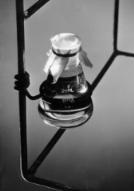
powered by SignMyGuestbook.com

powered by SignMyGuestbook.com
  
|
Wednesday, Nov. 29, 2006 - 10:50 a.m. The answer is yes, you can silk screen with paste. Cornstarch paste, anyway. Have not tried wheat paste yet. The problem giving rise to this discovery was that with these little tiny silkscreens I make, too small to stretch on a frame, too small even to use in my Gocco, the printing inks were too thin. It was just easier to use my fingers than a squeegee, because I could hold the screen in place and not have it slip around, like it wants to with a squeegee. (Plus all the fun of fingerpainting!) But the ink was too thin, it made a mess and squished out around under the design. No good. I read that someone had tried using wheat paste to print, but the problem was that on large prints, the starch bonds with the paper before you can finish, leaving the print stuck to the screen (tear to remove). But I'm not exactly doing large areas of color, so...? So make a paste of two parts water to one part cornstarch. Heat it on the stove--stir it around a lot once it starts to thicken. It will be a thick paste, almost like PlayDoh. Mix in colors-- I used the screen printing ink, but regular acrylics might work too? Then take your screen and squish the ink through. Depending on how much pigment you added, you can get cool translucent effects. Wait for the design to dry and print another over it-- shadows! Much potential for overlaying different colors. And much cheaper to play with and easier to mix colors. Of course, I have only four screen designs to play with right now-- two teapots, my business card, and some primitive-looking return address labels I cooked up this past weekend. Not exactly the material for the dramatic designs I'm fantasizing about. And of course, it's completely overcast today (I need sunlight to use StencilPro). On hold, once again.  previous next
previous next
� Leave a note |